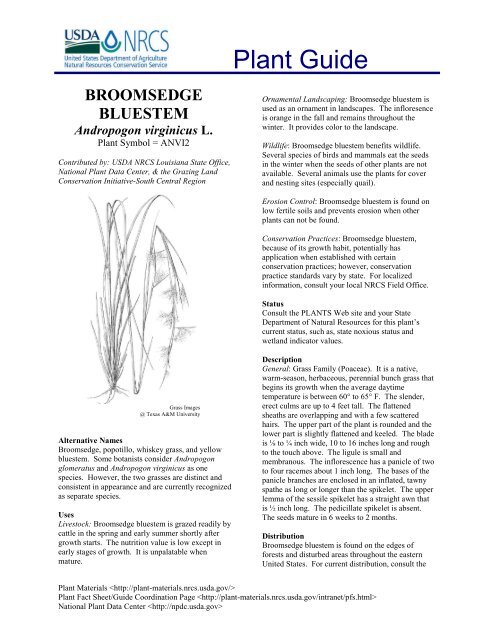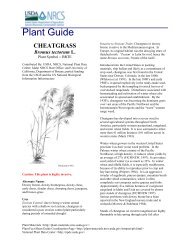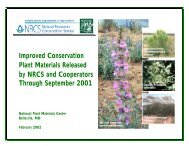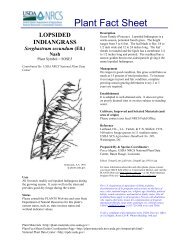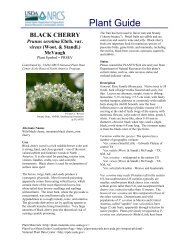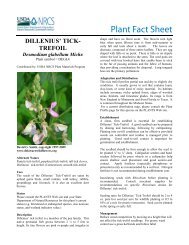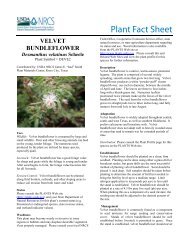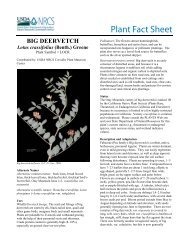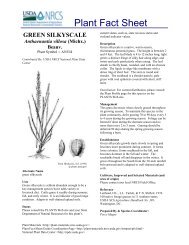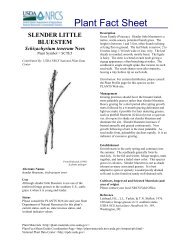broomsedge bluestem - USDA Plants Database - US Department of ...
broomsedge bluestem - USDA Plants Database - US Department of ...
broomsedge bluestem - USDA Plants Database - US Department of ...
Create successful ePaper yourself
Turn your PDF publications into a flip-book with our unique Google optimized e-Paper software.
BROOMSEDGE<br />
BLUESTEM<br />
Andropogon virginicus L.<br />
Plant Symbol = ANVI2<br />
Contributed by: <strong><strong>US</strong>DA</strong> NRCS Louisiana State Office,<br />
National Plant Data Center, & the Grazing Land<br />
Conservation Initiative-South Central Region<br />
Grass Images<br />
@ Texas A&M University<br />
Alternative Names<br />
Broomsedge, popotillo, whiskey grass, and yellow<br />
<strong>bluestem</strong>. Some botanists consider Andropogon<br />
glomeratus and Andropogon virginicus as one<br />
species. However, the two grasses are distinct and<br />
consistent in appearance and are currently recognized<br />
as separate species.<br />
Uses<br />
Livestock: Broomsedge <strong>bluestem</strong> is grazed readily by<br />
cattle in the spring and early summer shortly after<br />
growth starts. The nutrition value is low except in<br />
early stages <strong>of</strong> growth. It is unpalatable when<br />
mature.<br />
Plant Guide<br />
Ornamental Landscaping: Broomsedge <strong>bluestem</strong> is<br />
used as an ornament in landscapes. The infloresence<br />
is orange in the fall and remains throughout the<br />
winter. It provides color to the landscape.<br />
Wildlife: Broomsedge <strong>bluestem</strong> benefits wildlife.<br />
Several species <strong>of</strong> birds and mammals eat the seeds<br />
in the winter when the seeds <strong>of</strong> other plants are not<br />
available. Several animals use the plants for cover<br />
and nesting sites (especially quail).<br />
Erosion Control: Broomsedge <strong>bluestem</strong> is found on<br />
low fertile soils and prevents erosion when other<br />
plants can not be found.<br />
Conservation Practices: Broomsedge <strong>bluestem</strong>,<br />
because <strong>of</strong> its growth habit, potentially has<br />
application when established with certain<br />
conservation practices; however, conservation<br />
practice standards vary by state. For localized<br />
information, consult your local NRCS Field Office.<br />
Status<br />
Consult the PLANTS Web site and your State<br />
<strong>Department</strong> <strong>of</strong> Natural Resources for this plant’s<br />
current status, such as, state noxious status and<br />
wetland indicator values.<br />
Description<br />
General: Grass Family (Poaceae). It is a native,<br />
warm-season, herbaceous, perennial bunch grass that<br />
begins its growth when the average daytime<br />
temperature is between 60° to 65° F. The slender,<br />
erect culms are up to 4 feet tall. The flattened<br />
sheaths are overlapping and with a few scattered<br />
hairs. The upper part <strong>of</strong> the plant is rounded and the<br />
lower part is slightly flattened and keeled. The blade<br />
is ⅛ to ¼ inch wide, 10 to 16 inches long and rough<br />
to the touch above. The ligule is small and<br />
membranous. The inflorescence has a panicle <strong>of</strong> two<br />
to four racemes about 1 inch long. The bases <strong>of</strong> the<br />
panicle branches are enclosed in an inflated, tawny<br />
spathe as long or longer than the spikelet. The upper<br />
lemma <strong>of</strong> the sessile spikelet has a straight awn that<br />
is ½ inch long. The pedicillate spikelet is absent.<br />
The seeds mature in 6 weeks to 2 months.<br />
Distribution<br />
Broomsedge <strong>bluestem</strong> is found on the edges <strong>of</strong><br />
forests and disturbed areas throughout the eastern<br />
United States. For current distribution, consult the<br />
Plant Materials <br />
Plant Fact Sheet/Guide Coordination Page <br />
National Plant Data Center
Plant Pr<strong>of</strong>ile page for this species on the PLANTS<br />
Web site.<br />
Establishment<br />
Adaptation: Broomsedge <strong>bluestem</strong> is found in all <strong>of</strong><br />
Louisiana’s Major Land Resource Areas (MLRA)<br />
except for the Gulf Coast Marsh (151). The <strong><strong>US</strong>DA</strong><br />
Hardiness Zones for <strong>broomsedge</strong> <strong>bluestem</strong> is 5 to 10.<br />
It grows on a wide variety <strong>of</strong> soils, especially in old<br />
fields and other disturbed sites. It is frequently found<br />
with Andropogon glomeratus but in higher, betterdrained<br />
sites. However, <strong>broomsedge</strong> <strong>bluestem</strong> might<br />
have some allelopathic properties and may cause<br />
some other plants to not grow.<br />
Broomsedge <strong>bluestem</strong> is propagated from seeds or by<br />
plant division. However, <strong>of</strong> the two propagation<br />
methods, it is best to plant <strong>broomsedge</strong> <strong>bluestem</strong> by<br />
seeds. The seeds are produced 6 to 8 weeks from<br />
when the culms were produced.<br />
The seeds should be planted in late winter as a<br />
dormant seeding or when daily temperatures average<br />
in the low 60’s. The seed can be broadcast and cultipacked<br />
if the right field conditions exist. The seeding<br />
rate should be 10 to 12 pure live seed pounds/acre.<br />
The seeds should be planted to a depth <strong>of</strong> ¼ to ¾<br />
inch. If the right field conditions do not exist or<br />
intensive seedbed preparation is undesirable, then<br />
disk the site and leave the surface as rough as<br />
possible. Do not attempt to create a smooth uniform<br />
appearance for the seedbed. Broadcast the seed and<br />
leave it undisturbed. When seeding under minimal<br />
seedbed preparation, increase the seeding rate by<br />
50%.<br />
It is not recommended to mix <strong>broomsedge</strong> <strong>bluestem</strong><br />
seeds with cool season grass seeds. In parts <strong>of</strong> the<br />
United States where cool season grasses dominate,<br />
the warm season grasses can be taken over because<br />
they develop slower than the cool season grasses. It<br />
is also recommended that seed should not be moved<br />
more than 300 miles north, 100 miles east or west, or<br />
200 miles south <strong>of</strong> its point <strong>of</strong> origin.<br />
Management<br />
Broomsedge <strong>bluestem</strong> does not require fertilizers as<br />
the plants can grow in low fertility areas.<br />
Overgrazing and frequent haying <strong>of</strong> <strong>broomsedge</strong><br />
<strong>bluestem</strong> results in an increase <strong>of</strong> this plant.<br />
However, if <strong>broomsedge</strong> <strong>bluestem</strong> becomes weedy,<br />
then burning, plowing, or mowing is recommended.<br />
Check with the local extension service for<br />
recommended herbicides. Broomsedge <strong>bluestem</strong> has<br />
no known pests or problems.<br />
Cultivars, Improved and Selected Materials (and<br />
area <strong>of</strong> origin)<br />
Common seed is readily available from a number <strong>of</strong><br />
growers, wholesalers, and retailers <strong>of</strong> native plants.<br />
References<br />
Hitchcock, A.S. 1950. Manual <strong>of</strong> the grasses <strong>of</strong> the<br />
United States. <strong><strong>US</strong>DA</strong> Miscellaneous Publication No<br />
200. Agricultural Research Administration,<br />
Washington, D.C. Pp. 763-765.<br />
Texas A&M University 1997. Grass images:<br />
Andropogon virginicus.<br />
. Bioinformatics Working Group, College<br />
Station, Texas.<br />
<strong><strong>US</strong>DA</strong>, NRCS 2000. The PLANTS database.<br />
. 001106. National Plant<br />
Data Center, Baton Rouge, Louisiana.<br />
Prepared By<br />
Selena Dawn Newman, <strong><strong>US</strong>DA</strong>, NRCS, Louisiana<br />
Plant Materials Program<br />
Maraya Gates, <strong><strong>US</strong>DA</strong> NRCS National Plant Data<br />
Center<br />
Species Coordinator<br />
Mike Materne, Louisiana State University, Baton<br />
Rouge, Louisiana<br />
Edited 06dec00 jsp; 10feb03ahv; 24may06jsp<br />
For more information about this and other plants, please contact<br />
your local NRCS field <strong>of</strong>fice or Conservation District, and visit the<br />
PLANTS Web site or the Plant Materials<br />
Program Web site <br />
The U.S. <strong>Department</strong> <strong>of</strong> Agriculture (<strong><strong>US</strong>DA</strong>) prohibits<br />
discrimination in all its programs and activities on the basis <strong>of</strong><br />
race, color, national origin, sex, religion, age, disability, political<br />
beliefs, sexual orientation, and marital or family status. (Not all<br />
prohibited bases apply to all programs.) Persons with disabilities<br />
who require alternative means for communication <strong>of</strong> program<br />
information (Braille, large print, audiotape, etc.) should contact<br />
<strong><strong>US</strong>DA</strong>'s TARGET Center at 202-720-2600 (voice and TDD).<br />
To file a complaint <strong>of</strong> discrimination write <strong><strong>US</strong>DA</strong>, Director, Office<br />
<strong>of</strong> Civil Rights, Room 326-W, Whitten Building, 14th and<br />
Independence Avenue, SW, Washington, DC 20250-9410 or call<br />
202-720-5964 (voice or TDD). <strong><strong>US</strong>DA</strong> is an equal opportunity<br />
provider and employer.<br />
Read about Civil Rights at the Natural Resources Convervation<br />
Service.


